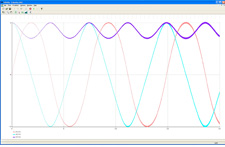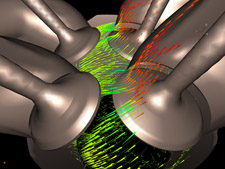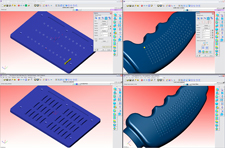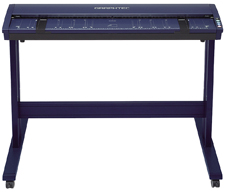Latest News
August 1, 2004
By DE Editors
 Math Modeling with Infinity 1.2.6
Math Modeling with Infinity 1.2.6
Infinity 1.2.6 from MathRevolt (Seattle, WA; website) adds the ability to work with polynoms and solve nonlinear nonstationary differential equations systems. Infinity 1.2.6 expands the possibilities of the company’s math software package to quickly analyze probable ranges of solutions. Infinity is intended for users who possess basic math knowledge and would like to solve complex math analysis tasks on a PC. For more information, visit the company’s website.
 ACUITIV Software Introduces Interactive CFD Visualization Solution
ACUITIV Software Introduces Interactive CFD Visualization Solution
ACUITIV Software (Batavia, IL; website), provider of next-generation computational fluid dynamics (CFD) visualization software, is now shipping ACUITIV v4.0. Enhancements contained in this new release enable ACUITIV to deliver a fully interactive, enterprise-class CFD visualization solution for industries worldwide, including automotive, aerospace and defense, power, and chemical processing.
Built on ACUITIV’s architecture, which is based on VR Juggler and OpenGL, ACUITIV v4.0 provides customers with a suite of interactive tools for transient model visualization, multi-PC visualization sessions, and steady-state model support. ACUITIV v4.0 opens new avenues for engineers, designers, and marketers to assist in their efforts to reduce time and cost of analysis, as a single solution can now be used enterprise-wide to analyze, communicate, and collaborate on a design.
Key features and benefits of v4.0 include the ability to read Fluent transient datasets plus an interactive tool suite for visualizing these complex datasets through the use of contours, isosurfaces, streamlines, pathlines, streaklines, timelines, and point queries; the ability to keeps track of the time element inherent in transient analysis; support for transient analysis across multiple computers and platforms; timelines connecting animated flow objects; flow animation options; improved color maps and the ability to use an x, y, or z contour plane to automatically generate a streamline box; and more. For information on pricing, visit the Acuitiv website.
 EnhanceD VX Array Functions
EnhanceD VX Array Functions
VX Corp. (Palm Bay, FL; website) has rewritten its 3D array tools in VX V9 to improve functionality. One such improvement is in its patterning tool, which is now available from one menu with a number of new options for defining patterns of any entity type (e.g., features, assembly components, entire models, or wireframes). In addition to linear and circular patterns,
In addition to uniform arrays, it is now possible to easily produce staggered pitch arrays. Arrays can be set to follow or wrap around a face or surface. They can also be set to fit inside a profile on that face, and any array positions can be selectively omitted along the array. Since VX is a hybrid modeler, feature arrays (e.g., copying a boss or rib to several positions) can be applied to open, nonmanifold surfaces—no solids required.
 Pair of Wide-Format Color Scanners
Pair of Wide-Format Color Scanners
Western Graphtec, Inc. (Irvine, CA; website) has added two new 40-in. color image scanners, the CS400 and CS300, to its stable of imaging products for CAD.
The new wide-format scanners use contact array image sensor technology for accurate, high-resolution scans, handling standard document sizes, including ISO A4 through ANSI E. Contact array image sensor technology does not require warm-up time and eliminates optical distortion often experienced with common CCD (charged coupled display) technology. With 600 dpi optical resolution, both models are accurate to 0.1% and are capable of handling long documents.
The CS400 is a 24-bit color model while the CS300 is an 8-bit color model. Both scan black and white and grayscale documents at a rate of 9ips, and color documents at 3ips at 400dpi. In addition to 600dpi, interpolated resolutions can be selected from 50dpi through 800 dpi in increments of 1dpi. The company’s driver software is provided standard, and has interactive menu setups and editing functions that can be saved for later use with similar documents. Advanced features incorporated in Scanning Master 21+ allow users to combine a CS series scanner with a large-format printer to create a multifunctional printing/copying system. Software features include Scan-to-Print, Scan-to-File, Scan-to-Email, and Scan-to-Copy functions. The CS400 and CS300 also support a wide variety of file formats including Bitmap, CAD ESP, TIFF, PCX, JPEG, and PDF.
New HP Workstations Add 64-bit Capability
Hewlett-Packard (Palo Alto, CA; website) announced a new line of engineering workstations ready for EM64T from Intel and PCI Express graphics technology: HP Workstation xw4200, xw6200, and xw8200.
The dual-processor xw6200 and xw8200 use EM64T technology. EM64T expands addressable memory space up to 256TB (terabytes). With it, engineers will be able to run 32-bit applications at full performance and also run 64-bit operating systems and applications.
The entry-level xw4200 uses Intel’s new high-performance 925X Express chipset and a single Pentium 4 with hyperthreading technology at speeds up to 3.6GHz with an 800MHz front side bus. The new chipset paves the way to such performance advances as PCI-Express graphics, integrated Serial ATA RAID controller and, when available, EM64T processor support.
The xw6200 and xw8200 support higher performance processors with double the amount of L2 cache as previous generation Xeons. The xw6200 can handle up to eight monitors simultaneously, and it scales with up to 16GB of RAM (when 2GB DIMMs are available) and 1.5TB of internal storage.
All units support Windows XP Professional as well as Red Hat Enterprise Linux WS 3.0. Shipping soon, the xw4200 is expected to start at $849. Available now, the xw6200 and xw8200 start at $1,399 and $1,799, respectively.
Wildcat Realizm 800 delivers PCI Express
3Dlabs Inc. (Milpitas, CA; website) announced its PCI Express-based Wildcat Realizm 800. PCI Express is the next level of graphics performance in Intel architecture-based platforms. PCI Express breaks the bandwidth bottleneck inherent in the PCI standard, offering gigabytes rather than megabytes of graphics throughput per second. Couple PCI Express with the Realizm 800’s Wildcat Realizm Vertex/Scalability Unit (VSU) and dual Realizm Visual Processing Units (VPUs) and you get a professional-grade graphics card delivering more than 700GFLOPS of floating-point graphics—double the raw graphics performance offered by other graphics solutions, according to the company.
The 16-lane PCI Express-based Wildcat Realizm 800 has a total of 512-bit bus to 512MB GDDR3 graphics memory. It integrates 128MB of onboard memory to store commands and geometry data for boosting intensive applications. It has a total of 640MB of onboard memory, delivering more than 64GBps of total memory bandwidth. Wildcat Realizm 800 also drives two dual-link DVI-I connectors and a stereo connector.
In related news, 3Dlabs introduced the Wildcat Realizm 100 and 200. These AGP 8x-based cards come with the Realizm VPU and up to 512MB of onboard memory. Both boards and the Wildcat Realizm 800 deliver programmability to OpenGL Shading Language and Microsoft DirectX 9.0 HLSL shader programs.
The Wildcat Realizm 800 will be available soon for $2,799. The Wildcat Realizm 100 and 200 are $1,249 and $1,599, respectively.
Molding Simulation Software Targets Liquid Composites
PAM-RTM liquid composite molding (LCM) simulation software from ESI Group (Bloomfield Hills, MI; website) has been updated to release 2004. The key technological enhancement in PAM-RTM 2004 is VARI (vacuum-assisted resin infusion) simulation. This functionality enables manufacturers to efficiently simulate very large composite structures that cannot be manufactured with traditional closed molds, such as windmill blades, ship decks and hulls, and large aircraft parts. VARI simulation takes into account the permeability variations caused by the deformation of fibrous reinforcement during resin injection, enabling engineers to anticipate manufacturing problems that could not be simulated previously.
CPU management optimization makes PAM-RTM 2004 twice as fast as the previous release. Among the capabilities new to PAM-RTM 2004 are contact resistance for thermal modeling and improved functionality for air bubbles entrapment detection. Also, users can now define viscosity and curing functions, enabling them to simulate new resins as they come to market.
PAM-RTM 2004 offers a seamless integration of the solver, pre-, and postprocessing. New automatic mesh modification functionality is available for runners and injection points. This saves time when process-tuning and optimizing runners as well as positioning injection gates, since the mesh modifications are done directly in PAM-RTM 2004 rather than the MCAD model.
In addition to its new VARI capabilities, PAM-RTM can simulate such manufacturing processes as RTM (resin transfer molding) and VARTM (vacuum-assisted RTM). It’s available for Windows NT, 2000, XP, and for Unix/Linux.
Optimization Toolbox
Maplesoft (Waterloo, ONT; website) recently announced the Global Optimization Toolbox for its Maple 9.5 productivity environment. The Global Optimization Toolbox is meant to ensure that you obtain the best answer to modeling problems that have many possible solutions, under complicated constraints.
The Global Optimization Toolbox incorporates solver modules for nonlinear optimization problems, including branch-and-bound global search, global adaptive random search, and multistart-based global random search. Global solutions can be further refined by local search using the reduced gradient method. It can solve models with thousands of variables and constraints. It supports arbitrary objective and constraint functions.
The Global Optimization Toolbox is available for all supported platforms. Price: $1,695.
Better Mold Analyses/Optimizations
Moldflow Manufacturing Solutions 2.0 (MMS 2.0) from Moldflow Corp. (Wayland, MA; website) offers new process-monitoring capabilities for multibarrel injection molding equipment and a new hybrid display for process analysis and control for the metal die cast market.
MMS 2.0 provides the ability to schedule, manage, and monitor advanced multimaterial, multibarrel injection molding machines. For metal die cast applications, it offers a new position-based display format for process analysis and control. The hybrid display shows velocity and pressure as a function of position with a switchover to a time-based display in mid-cycle.
MMS 2.0 also includes tracking of machine-related labor activities by individual operator, such as data entry for scrap, downtime for flash removal, and quality inspections.
Ultra-Portable CMM
Arc Second (Springfield, MA; website) offers Vector Bar, a low-cost, handheld tool to give users of traditional portable or standard CMMs (coordinate measuring machines) an alternative for measurement, inspection, and reverse engineering applications.
Vector Bar uses Arc Second’s indoor GPS technology, letting users use an unlimited number of Vector Bars within the indoor GPS-enabled work area. Vector Bar can run on batteries and comes with wireless communication. It works with most metrology software.
Generate 24-bit Color PDFs, TIFFs, and Other Formats
Spicer Corp. (Kitchener, ONT; website) has released DocuJet 3.0, a multipurpose tool that generates raster image files from any Windows application. DocuJet 3.0 delivers performance and accurate file conversion to help firms conform to standards, eliminate print and scan-to-file processes, speed fax queues, generate images for archival purposes, and view and share images without native applications.
The redesigned DocuJet 3.0 offers such new features as the flexibility to convert a Windows document to full 24-bit color, grayscale, and black and white raster images in BMP, JPEG, PCX, PDF, PNG, and TIFF formats. New profiles let you save sets of commonly used options for processing documents and easily share these settings with other users. Other features include custom resolutions set by the user; the ability to set your file name to the original document name provided by the authoring application; stamps, such as date and time, on your renditions as they are generated; and a configuration utility that specifies the options available by turning settings on and off. Download your free evaluation copy at spicer.com.
Connect almost Any Serial Device to an Ethernet network and the Internet
The iServer from Omega Engineering (Stamford, CT; website) iServer is a new series of microservers that connect serial devices to an Ethernet network and the Internet. Type the device’s name in a Web browser, and the iServer delivers up Web pages that let you configure it for your specific application without special software.
The iServer takes a dynamically assigned IP address from a DHCP server on your network to get started. Or you can assign a static IP address to the iServer, if necessary. The IP address can be assigned locally with its serial connection, as well as remotely over an Ethernet network using Telnet or a Web browser.
Price: $195.
Flotherm 5 Improves import and Modeling
Flomerics (Southborough, MA; website) has introduced Flotherm Version 5, the newest release of its thermal-management software for simulating complicated electronics cooling problems. Flotherm 5 features usability, CAD import, compact modeling, and numerical stability improvements. It can work in conjunction with other Flomerics products, enabling engineers to address interrelated performance issues such as electromagnetic compatibility, reliability, and stress concurrently.
Analysis accuracy now incorporates a grid-based dissection CAD import method said to provide better handling of complex product geometries. The grid-based dissection reproduces an imported solid model’s shape to a high level of accuracy, while maintaining numerical efficiency and avoiding issues relating to the quality and accuracy of the imported data. For transient analyses, a new feature allows importation of a comma-delimited ASCII file defining any desired power versus time profile.
Flotherm 5 also has new features that support the emerging JEDEC guidelines on best practice for the creation of thermal compact component models. Numerical stability has been enhanced through refinements to its object-based localized gridding.
Virtual.Lab Extended
LMS International (Troy, MI; website) has announced Virtual. Lab Rev 4, the newest edition of its integrated environment for simulating mechanical system performance. Rev 4 introduces a new LMS Virtual.Lab Morphing module and offers increased performance and capabilities in all application modules including motion, noise and vibration; interior and exterior acoustics; and durability.
The Morphing module enables engineering teams to quickly morph or modify an existing finite element model into new FE models corresponding to the target design. This lets teams perform many analyses before complete MCAD or new FE models are available.
The Acoustics module now lets engineers automatically optimize the acoustic performance of a design while systematically updating FE models. Interior Acoustics includes the ability to model the vibro-acoustic behavior of a vehicle body and to simulate interior sound. It also has cavity-meshing capabilities that start from a structurally full vehicle or trimmed body model and automatically generates the FE mesh for the cavity.
Collaboration Brings Design to Enterprise
Proficiency (Marlborough, MA; website) has announced the Collaboration Gateway 3.5.
Key enhancements in this feature-based MCAD interoperability solution include support for assembly constraints, surfacing features, and methodology; and enhanced support for top-down associative design techniques. The Collaboration Gateway V3.5 enables assembly constraints such as mate/ contact, offset/distance, align, coincidence, fix, and coordinate systems to be interoperable between MCAD systems. Its new surface type support includes surface copy, replace, extend, protrusion, and more.
Also included is the Proficiency UPR Viewer, a lightweight application that allows MCAD and non-MCAD users within an organization to query, view, and leverage the product design data defined within MCAD models and assemblies, independent of the original authoring system.
As with prior releases, the Collaboration Gateway V 3.5 offers a feature set for high-throughput exchange of MCAD models between CATIA v4 and v5, Pro/Engineer and Wildfire, and Unigraphics NX and I-deas NX Series.
For more information, visit Proficiency’s website.
Subscribe to our FREE magazine, FREE email newsletters or both!
Latest News
About the Author
DE’s editors contribute news and new product announcements to Digital Engineering.
Press releases may be sent to them via [email protected].






